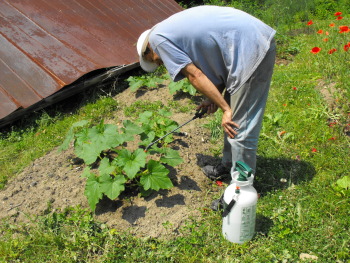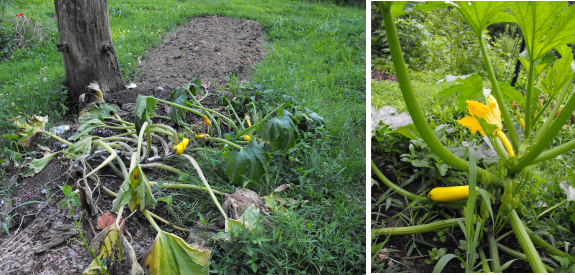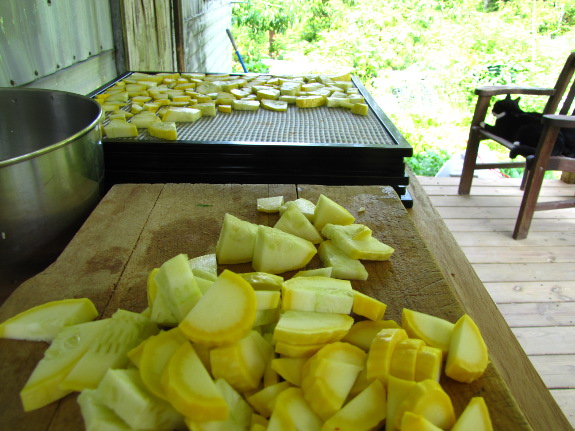
How to beat vine borers with succession planting
 Squash vine borers were our archnemesis during our
early years on the farm, so much so that I even resorted to spraying Bt
on the plants' stems. And I'm glad to say that the Bt didn't
help. Why am I glad? Because if that seemingly innocuous*
spray had proven effective, I might not have figured out less intrusive
ways to keep vine borers in check.
Squash vine borers were our archnemesis during our
early years on the farm, so much so that I even resorted to spraying Bt
on the plants' stems. And I'm glad to say that the Bt didn't
help. Why am I glad? Because if that seemingly innocuous*
spray had proven effective, I might not have figured out less intrusive
ways to keep vine borers in check.
Variety selection was part of my solution, as I'll
explain in a later post, but the biggest reason I started being able
to harvest summer squash is because I learned to succession plant these
speedy vegetables biweekly in the summer garden. Here in zone 6
(last frost: May 15, first frost: October 10), I plant crookneck
(summer) squash on May 1 (a gamble), May 15, June 1, June 15, and July 1
(a slight gamble),
a schedule that allows us to be overwhelmed with tasty squashes despite
heavy vine-borer
pressure and with the use of no other control measures beyond variety selection.

 Succession planting is handy with other types of
vegetables as well, although the strategy only works if you choose
varieties that put out a big harvest right away. For example, I
succession plant bush beans rather than growing runner beans since the
former provide lots of green beans before the bean beetles move in to
dine. On the other hand, succession planting wouldn't be a good
choice for tomatoes since even determinate varieties require months of
growth before they ripen their first fruit.
Succession planting is handy with other types of
vegetables as well, although the strategy only works if you choose
varieties that put out a big harvest right away. For example, I
succession plant bush beans rather than growing runner beans since the
former provide lots of green beans before the bean beetles move in to
dine. On the other hand, succession planting wouldn't be a good
choice for tomatoes since even determinate varieties require months of
growth before they ripen their first fruit.
Another benefit of succession planting comes when the
food reaches our table. A few studies have suggested that
cucurbits (and perhaps other vegetables) have more micronutrients on
hand when they mature their first fruits, so the earliest harvest often
tastes best. Some gourmet farmers pull out their squash vines after the first harvest as a
matter of course, figuring it's better to
maximize flavor rather than yield. So maybe the borers are trying
to do me a favor by prompting me to eat the most nutrient-rich and
tasty vegetables possible?
I hope you enjoyed this excerpt from Naturally Bug-Free!
If so, you can download the ebook for $1.99 on Amazon by clicking the
link above. Or just wait for another excerpt tomorrow on the blog.
* The glossary of Naturally Bug-Free suggests some ways in which Bt might not be as safe as many of us think.
| This post is part of our Naturally Bug-Free lunchtime series.
Read all of the entries: |
Want more in-depth information? Browse through our books.
Or explore more posts by date or by subject.
About us: Anna Hess and Mark Hamilton spent over a decade living self-sufficiently in the mountains of Virginia before moving north to start over from scratch in the foothills of Ohio. They've experimented with permaculture, no-till gardening, trailersteading, home-based microbusinesses and much more, writing about their adventures in both blogs and books.
Want to be notified when new comments are posted on this page? Click on the RSS button after you add a comment to subscribe to the comment feed, or simply check the box beside "email replies to me" while writing your comment.
- Remove comment
- Remove comment
- Remove comment
- Remove comment
